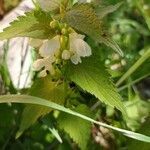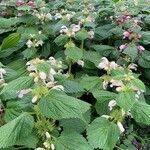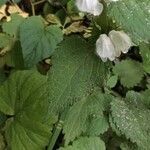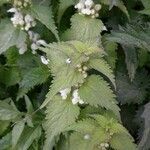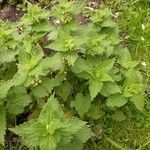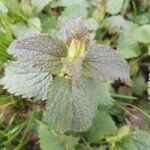Perennial rhizomatous herb with hairy stems ascending to c. 50 cm. Lower lvs with slender petioles to 5 cm long; upper lvs and bracts with shorter petioles. Lamina 4-8 × 2-5 cm, ovate, hairy, especially above, crenate-serrate, sometimes deeply cut; base cordate or subcordate. Bracts very similar to lvs. Calyx 10-12 mm long, hairy; teeth slightly > tube, subulate. Corolla 1.8-2.3 cm long, white with hairy ring inside near base; upper lip c. 1 cm long, tomentose outside; lateral lobes of lower lip with 2 small teeth. Nutlets c. 2.5 mm long, sharply angled, patterned white.
A herb which keeps growing from year to year. It is creeping. The stems are 30-60 cm high. They can have bristles. The leaves near the base are smaller. The leaf stalk of the upper leaves is 1-6 cm long. The upper leaf blade is oval or sword shaped and 2.5-6 cm long by 1.5-4 cm wide. There are teeth along the edge. The base is heart shaped. Flowers are purple-red.
